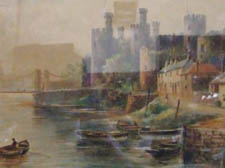|
|
 |
| |

Drinkwater’s painting of Conwy Castle, one of three stolen from Ms Gerber |
‘Good samaritan’ pleads for the return of her paintings
Works by little-known artist held sentimental value from childhood
WATERCOLOURS by a long-forgotten Victorian commercial artist might not cause a big stir among the big art collectors of Belsize Park and Hampstead, but to one of Camden’s genuine good samaritans they meant the world.
Big-hearted Rona Gerber, 82, who has provided shelter in her Belsize Park home to the homeless and people suffering from heroin addiction, has been devastated by the theft of three treasured paintings.
She doesn’t want the thief to go to jail – she just wants the pictures back.
The retired teacher spotted a painting of Conwy Castle, in north Wales, while rummaging in a Queen’s Crescent junk shop 30 years ago. It brought memories flooding back of her war-time evacuation, when she had been sent to live in the shadow of the castle with her twin sister, Verna.
The picture, by Albert “Milton” Drinkwater, took pride of place in her home until last week – when it disappeared with two others by the same painter.
Now she wants the help of second hand shops, art dealers and maybe even New Journal readers to find the missing paintings.
The works by the minor landscape artist include a rendition of a shepherd with his flock and another of labourers’ cottages, which was torn and fixed by Ms Gerber. The artist’s work fetches around £100 per painting, and never more than £400, and Mrs Gerber says their worth to her is solely sentimental.
Ms Gerber, who worked as an infant school teacher after training at the Hornsey College of Art, said: “I bought the pictures in 1984 because I recognised Conwy Castle. I borrowed the money from my father to buy them.
“I was evacuated there during the war with my twin sister and it became our adventure playground. I have very happy memories of playing there. I was very attached to it and was very upset they were taken.”
Drinkwater was from Cheshire and earned a living as an artist in Liverpool in the latter half of the 19th century. He was prolific – the artist’s great grandson Nigel Drinkwater told the New Journal that he had tracked down 189 pieces by his relative, and his works captured the Victorian vogue for English holidays.
While the Queen and Prince Albert made Scotland a popular destination with her visits to Balmoral, the railways and advent of charabanc day trips meant even the working classes could travel further afield.
This fuelled a market for rural scenes of popular beauty spots to remind holiday makers of places they had visited.
Mr Drinkwater said his relation had been a great hiker. He said: “Milton loved the countryside and picked up on the idea of painting holiday scenes. He hawked his works door to door and made just enough through his paintings to live on.”
Ms Gerber said she did not feel any anger towards the person responsible for the theft.
She said: “I believe I know who may have taken them. They simply have sentimental value for me. If anyone is offered them, or knows where they are, I’d dearly love to have them back – no questions asked.”
And she says she even understands the motives of the person she believed may have taken them from her.
She said: “I have found opiate addicts are relatively honest but they have cravings that they cannot control.
“I can forgive them.” |
 |
|
|
 |
| |
| |
|
 |
|